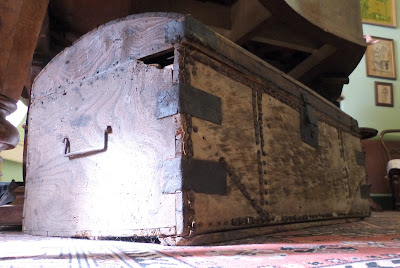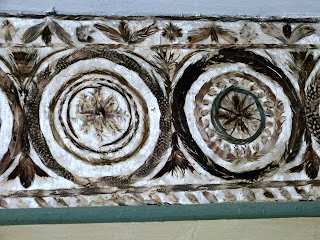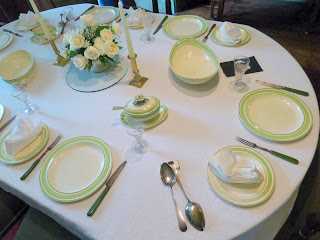 |
| A la Ronde, Devon |
A la Ronde is a 16-sided house near Exmouth, Devon, owned by the National Trust.
 |
| A la Ronde and the view down to the sea, near Exmouth, Devon |
The Parminters of A la Ronde
The story of A la Ronde starts in 1784 when a group of single ladies went on the Grand Tour. The party consisted of Jane Parminter (1750-1811), her sister Elizabeth (1756-91) (1), her cousin’s orphaned daughter Mary Parminter (1767-1849) and another single lady, Miss Colville. The tour was financed by Jane’s wealth and lasted for about four years, though possibly longer for some of the party. Elizabeth became ill and returned to England in 1788; Jane and Mary may not have returned until 1791 when Elizabeth died.
 |
| One of the Parminters' packing cases in the Music Room, A la Ronde |
The building of A la Ronde
By the time they returned to England, Mary had inherited a considerable fortune. She and Jane decided to build a house to live in together rather than be forced into marriages that they did not desire. The result was A la Ronde, said to have been inspired by the octagonal basilica of San Vitale at Ravenna in Italy that they had seen during their Grand Tour.
 |
| The Octagon, A la Ronde, as reflected in the the glass globe hanging down in the centre of it. You can see all the doorways off it (as well as us!) |
The design of A la Ronde
Inside the house, there is a central octagon and all the other rooms come off this, as well as linking into each other by means of tiny lobbies, some of which still exist today. The rooms facing east were the ladies’ two bedrooms and they moved round the house during the day, following the natural light.
 |
| One of the diamond windows of A la Ronde from the inside |
 |
| One of the lobbies between the downstairs rooms of A la Ronde. This one houses a library. |
The two cousins were very industrious and spent many hours crafting works of art. They decorated tables, made feather pictures and, at the top of the house, they created an incredible Shell Gallery - a mosaic room, with the walls adorned with shells and other treasures.
 |
| Cabinet of curiosities in the Library of A la Ronde |
 |
| A table inlaid by one of the Parminter cousins in the Drawing Room, A la Ronde |
The legacy of A la Ronde
On her death, Mary Parminter left A la Ronde to six unmarried female relations in a specified sequence. If they married, they forfeited their right to inherit. In 1880, Stella Reichel, the third lady to inherit, was due to get married. Only one of the other named ladies still met the conditions of the bequest and she sold the reversion to Stella enabling her to sell A la Ronde to her brother, the Reverend Oswald Reichel, before her marriage. He became A la Ronde’s only male owner.
 |
| Miniature of Mary Parminter in the Dining Room, A la Ronde |
During this time, the house saw the most change. Externally, extra windows were added, the thatch on the roof was replaced by tiles and a raised walkway was added round the outside of the roof, whilst inside, the Reverend installed central heating, knocked down walls and added stairs. Several times the house was saved from redevelopment and in 1991 it was purchased by the National Trust.
What can you see today?
• The outside of the house is much like it was in the Reverend Reichel’s day. The diamond-shaped windows with shutters were originally the only windows and every single one of them is on an angle to bring in the most light.
 |
| One of the original diamond windows of A la Ronde |
• The Study and the Music Room were originally Jane and Mary’s bedrooms. There is a wonderful George III tea caddy in the first of these rooms.
 |
| George III tea caddy in the Study, A la Ronde |
• In the Library, there is a model of the house which shows what it was like before the Reverend Reichel’s alterations and a miniature 18th century bookcase holding a collection of tiny schoolbooks.
 |
| Model of A la Ronde before the Reverend Reichel's alterations In the Library, A la Ronde |
• From the upper level, you can glance up the staircase to the Shell Gallery. It is too fragile for visitors to be allowed up, but there are interactive screens later in the tour that allow you to virtually walk around the room.
 |
| View up the stairs into the Shell Gallery, A la Ronde |
 |
| View of the Shell Gallery, A la Ronde, from the interactive screen |
 |
| View of the Shell Gallery, A la Ronde, from the interactive screen |
• The Octagon is the central room of the house and is full height, right up into the Shell Gallery. There are mirrors here that allow you to see the ceiling and the shells on the walls peeping over the balcony.
 |
| View up into the dome above the Octagon, A la Ronde |
• The Drawing Room was created by the Reverend Reichel out of two of the original rooms and its intervening lobby. There are lots of treasures in here – the feather frieze around the top of the room, worktables decorated by the two Parminter cousins and my personal favourite—the most wonderful silhouette ink drawing by François Torond of the Parminter family in 1783.
 |
| Feather border in the Drawing Room, A la Ronde |
 |
| Inlaid worktable by one of the Parminter cousins In the Drawing Room, A la Ronde |
 |
| A silhouette ink drawing of the Parminter family in 1783 by François Torond - above the mantelpiece in the Drawing Room, A la Ronde |
• The Dining Room also holds many gems – a late 18th century Wedgwood cream ware dining service and a sideboard with pull-out holders for red and white wine for which the room was specially designed.
 |
| The table laid with Wedgwood cream ware in the Dining Room of A la Ronde |
 |
| A broken piece of Wedgwood cream ware in the Pantry of A la Ronde |
 |
| The sideboard in the Dining Room, A la Ronde |
 |
| A Chinese Quianlong figure c1780 in the Dining Room, A la Ronde |
Last visited: August 2015
Note
(1) The National Trust guidebook states Elizabeth’s death as 1795 but The Story of A La Ronde and Its People says that Jane was in London for the administration of her sister’s will in 1791 and the probate record supports this date.
Meller, Hugh, A La Ronde, National Trust guidebook (1993, this edition 2004)
National Trust, The Story of A La Ronde and Its People (2011, revised 2013)
All photos © Andrew Knowles - more of Andrew's photos of A la Ronde on Flickr.

Thanks so much for sharing these pictures! There is a short segment on A La Ronde in Amanda Vickery's "At Home with the Georgians" and I've been wanting to see more ever since. I'm interested in "female acccomplishments" and A La Ronde seems like a fascinating showcase for these ladies' talents.
ReplyDeleteJane and Mary Parminter were remarkable women - artistically talented, adventurous and charitable - and, notably, unmarried, independent women.
Deleteim a parminter and have been fascinated with ala ronde, my family are directly connected to jane and mary and now residing in devon i am looking forward to visiting ala ronde.
ReplyDelete